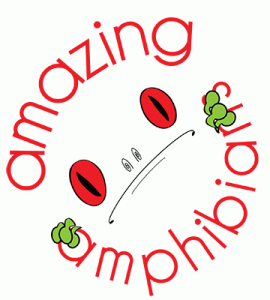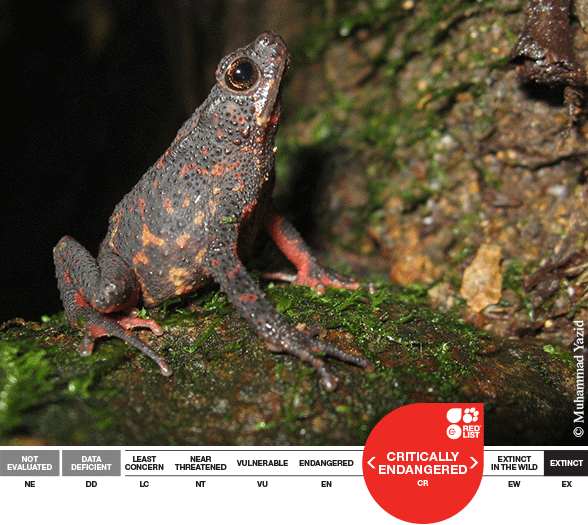 The Bleeding Toad, Leptophryne cruentata, is listed as ‘Critically Endangered’ on the IUCN Red List of Threatened SpeciesTM. It is endemic to West Java, Indonesia, specifically around Mount Gede, Mount Pangaro, and south of Sukabumi. This toad is most commonly found near small creeks in the mountains. The female lays her eggs in clutches in the creeks. The Bleeding Toad’s scientific name, cruentata, is from the Latin word meaning “bleeding” because of the frog’s overall reddish-purple appearance and blood-red and yellow marbling on its back.
The Bleeding Toad, Leptophryne cruentata, is listed as ‘Critically Endangered’ on the IUCN Red List of Threatened SpeciesTM. It is endemic to West Java, Indonesia, specifically around Mount Gede, Mount Pangaro, and south of Sukabumi. This toad is most commonly found near small creeks in the mountains. The female lays her eggs in clutches in the creeks. The Bleeding Toad’s scientific name, cruentata, is from the Latin word meaning “bleeding” because of the frog’s overall reddish-purple appearance and blood-red and yellow marbling on its back.
 |
The population declined drastically after the eruption of Mount Galunggung in 1987. It is believed that other declining factors may be habitat alteration, loss, and fragmentation. Although the amphibian chytrid fungus has not been recorded in this area, the sudden decline in a creek-side population is reminiscent of declines in similar amphibian species due to the presence of this pathogen. Only one individual Bleeding Toad was sighted from 1990 to 2003.
Part of the range of Bleeding Toad is located in Gunung Gede Pangrango National Park. Future conservation actions should include population surveys and possible captive breeding plans.
Submit your observations of this species to iNaturalist and they will appear on this map. Learn more about this species on Amphibiaweb.
More Amazing Amphibians here.
Produced in partnership with:
Senior Partners |
|||
 |
 |
 |
|
 |
 |
||
Focal Partners |
|
 |
|
Affiliates |
|||
 |
 |
||
How to become an Amazing Amphibians partner:
Outlined below are the roles and responsibilities for the 4 different levels of involvement for potential partners. If your organization would like to be a part of the Amazing Amphibians program in either of these capacities please email amazing@amphibians.org.
Senior Partner – These partners will help with multiple aspects of the program, help facilitate the completion of several species profiles, publicize each Amazing Amphibian and will likely have a landing page for the program on their website. This level of partner will be leading in using their communication channels to gather additional information for the program such as images and data points for iNaturalist.
Strategic Partner – These partners will play an active role in creating species profiles, submitting at least three species profiles per year and actively use their social network to publicize each Amazing Amphibian. This level of partner will be active in using their communication channels to gather additional information for the program such as images and data points for iNaturalist.
Focal Partner – Partners tend to be active in a limited geographic area. This partner will submit at least one regional species profile per year and use their social network to publicize each Amazing Amphibian. This level of partner will be involved in using their communication channels to gather additional information at a regional level for the program such as images and data points for iNaturalist.
Affiliate – These partners are interested in promoting the program but might not be in a position to provide profiles. These partners will publicize each Amazing Amphibian through the social media outlets.







